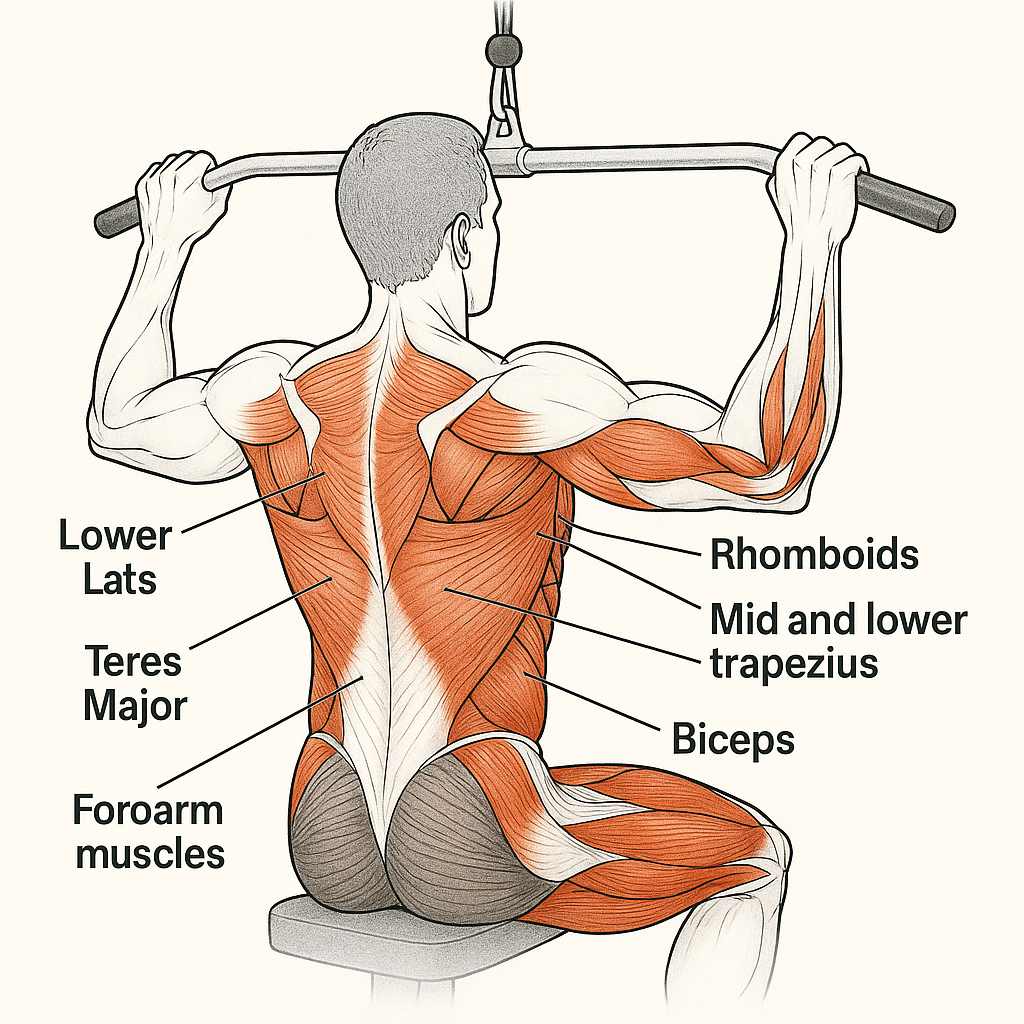The close grip lat pulldown primarily targets the lower latissimus dorsi, while also activating your biceps, rhomboids, and mid-back muscles for a powerful and balanced upper-body workout. If you want to build a stronger, thicker back, understanding which muscles are worked during the close grip lat pulldown is essential. This knowledge helps you optimize your workouts, avoid common mistakes, and achieve better muscle growth.
In this guide, you’ll get a clear, research-backed explanation of every muscle worked in the close grip lat pulldown, plus actionable tips for maximizing results. We’ll also cover key benefits, common FAQs, and how the close grip version differs from other lat pulldown styles.

What Is a Close Grip Lat Pulldown?
A close grip lat pulldown is a machine-based exercise performed with a narrow, neutral or supinated (palms facing you) grip, typically using a V-bar or close-grip handle. This grip changes the angle of pull, emphasizing the lower lats and shifting some of the workload to the biceps and mid-back.
Main Muscles Worked by Close Grip Lat Pulldown
1. Latissimus Dorsi (Lower Lats)
The primary muscle targeted is the lower portion of the latissimus dorsi. The close grip position recruits more fibers from the lower and middle lats, helping build thickness and definition through the back’s center. According to a 2024 EMG study published in the Journal of Strength and Conditioning Research, the close grip activates the lats as effectively as a wide grip, but with greater lower lat emphasis. Source
2. Teres Major and Rhomboids
Teres major assists the lats in shoulder extension and adduction, playing a supporting role in the movement. Rhomboids retract and stabilize your shoulder blades as you pull the handle downward, giving you better posture and upper back strength.
3. Trapezius (Mid and Lower Fibers)
The mid and lower trapezius help depress and retract your scapulae (shoulder blades), preventing excessive shrugging and stabilizing your upper body during the pull.
4. Biceps Brachii, Brachialis, and Brachioradialis
Your biceps and brachialis (elbow flexors) work hard during the close grip pulldown. The narrower grip increases elbow flexion, leading to greater biceps activation compared to wide grip variations. Brachioradialis also assists in flexing your elbow, especially with a neutral grip.
5. Posterior Deltoids
The rear delts help stabilize your shoulders and support arm movement throughout the range of motion.
6. Forearms and Grip Muscles
Forearm muscles, particularly the flexors and grip stabilizers, are engaged to hold the handle securely, especially as the weight increases.
7. Core and Spinal Erectors
Your core and erector spinae work isometrically to keep your torso stable and upright, preventing excessive swinging or arching.
Table: Muscles Worked by Close Grip Lat Pulldown
| Muscle Group | Role | Activation Level |
|---|---|---|
| Latissimus Dorsi (Lower) | Primary Mover | ★★★★★ |
| Teres Major | Assistance | ★★★★☆ |
| Rhomboids | Scapular Retraction | ★★★★☆ |
| Mid/Lower Trapezius | Scapular Depression | ★★★★☆ |
| Biceps Brachii & Brachialis | Elbow Flexion | ★★★★☆ |
| Brachioradialis | Forearm Flexion | ★★★★☆ |
| Posterior Deltoids | Shoulder Stability | ★★☆☆☆ |
| Forearms | Grip Stability | ★★★★☆ |
| Core/Erector Spinae | Torso Stability | ★★★☆☆ |
Benefits of Close Grip Lat Pulldown vs. Wide Grip
Key Differences
- Close grip builds back thickness: Focuses on the middle and lower lats for a dense, powerful look.
- More biceps involvement: Greater elbow flexion means your arms get a secondary workout.
- Joint-friendly: Neutral or close grips reduce shoulder stress, making it a safer choice for many lifters. Source
- Wider range of motion: Allows for a deeper stretch and peak contraction of the lats.
Research & EMG Data
A 2024 review in Sports Biomechanics confirms that close and medium grip lat pulldowns activate the lats and biceps as well as, or even better than, wide grip variations for many athletes. Source
Proper Form: How to Maximize Muscle Activation
Tips for best results:
- Sit upright with a slight lean back (10–20°).
- Retract your shoulder blades before pulling.
- Pull the handle down to your upper chest, leading with your elbows.
- Squeeze your lats at the bottom; control the weight on the way up.
- Avoid using momentum or swinging your torso.
Common Mistakes to Avoid
- Pulling behind the neck (can injure shoulders).
- Using excessive weight, leading to poor form.
- Flaring elbows out too wide.
Frequently Asked Questions
Is close grip better for lats than wide grip?
Close grip targets the lower and middle lats more for thickness, while wide grip emphasizes width. Both are effective, but close grip is safer for shoulders and better for biceps involvement.
Does close grip lat pulldown build biceps?
Yes, the close grip variation significantly recruits the biceps and brachialis, making it a great accessory for arm development.
Can beginners use the close grip lat pulldown?
Absolutely. Start light, focus on form, and gradually increase resistance as your strength improves.
Pricing, Membership & Access
Most commercial gyms in the U.S.—including Planet Fitness, LA Fitness, and Gold’s Gym—offer close grip lat pulldown machines. Day passes typically cost $10–$20, while monthly memberships range from $24.99 to $39.99 depending on amenities. Check your local gym’s official website for up-to-date pricing and equipment availability.
Conclusion
The close grip lat pulldown is a must-have move for anyone seeking a strong, thick, and balanced back. By targeting the lower lats, mid-back, and biceps, this exercise delivers noticeable results for lifters of all levels. Ready to get started? Try adding the close grip lat pulldown to your next back workout—and enjoy faster muscle growth, better posture, and improved pulling strength.
